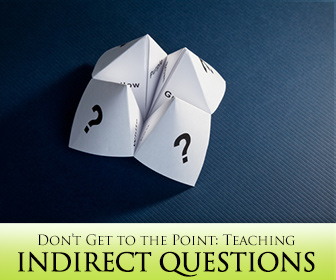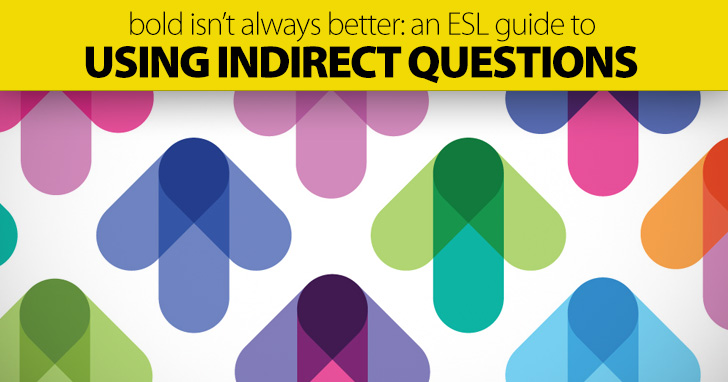Donít Get to the Point: Teaching Indirect Questions


It’s possible that the question made you uncomfortable because it was a direct question, that is it wasn’t hedged in a larger sentence to soften the inquiry. It’s important in English to know when and how to ask indirect questions, ones that soften the edge of direct questions. Here is how you can go about teaching indirect question to your ESL students.

Direct and indirect questions refer to different grammatical structures. They are used in grammar to distinguish between a question in a main clause and a question in a dependent clause. Most questions that ESL students ask and answer are direct questions. They appear in the main clause of a sentence. Indirect questions, also called embedded questions, are common among English speakers, and your students should know how to form them. These are questions that appear in a dependent clause in a sentence. Embedded questions are used for several reasons. In some cases, an indirect question is more polite than a direct question. In many ways, an embedded question is softer and can take an aggressive edge off of a direct question. Indirect questions are also used in more formal speech or in business situations.
In English, there are two steps in forming questions. When the question is an information question (using who, what, where, when, why, or how) the question is formed by moving the question word to the front of the sentence and changing the word order of the subject and verb.
If the verb has a helping verb, also called an auxiliary verb, it is moved before the subject of the sentence. If the verb does not have a helping verb, do is inserted before the subject of the sentence to make a question.
Indirect questions are different from direct questions in more than name. Since they are questions embedded in a dependent clause, they do not require the movement of the helping verb or the insertion of do. The question word, however, is still moved to the beginning of the clause. Take the following examples. The first sentence shows the underlying structure of the statement. To change it to a question, we must move the question word to the beginning of the sentence and change the order of the helping verb. We also end the sentence with a question mark because the main clause (in this case the only clause) is a question.
Now look at the underlying structure of the embedded question.
To change the dependent clause to question format (form an embedded question), you must move the question word to the beginning of the clause, but you do not change the order of the helping verb.
And since the question is embedded in a dependent clause, you do not use a question mark at the end of the sentence.
Here is another example. We start with the underlying structure of the sentence and then add do to form a yes/no question.
We can also embed this question in a dependent clause. But because it is a yes/no question, we will use if at the beginning of the dependent clause rather than adding do as in the question above.
Note that the embedded question does not end with a question mark. This is an area where many students make mistakes, but the punctuation of the sentence depends on whether the main clause is a statement or a question. In this case, the main clause is a statement, so the punctuation of the sentence as a whole is for a statement. Other phrases that may begin an indirect question include the following.
It is possible for an embedded question to appear within a question. In such cases, the sentence is punctuated with a question mark because the main clause is a question. Take the following sentences for example.
It is correct to punctuate the last sentence with a question mark because the main clause is a question: do you know…? The use of a question mark at the end of the sentence has nothing to do with the embedded question. It could just as easily be embedded in a statement and be followed by a period.
Some phrases that might introduce an indirect question within a question include the following.
Using embedded questions requires a firm understanding of English grammar, and it isn’t for students just learning the rules for the language. But high intermediate and advanced students will need to use and understand indirect question use. When it’s time to tackle the subject with your class, take it slowly, one step at a time, and your students will end up being able to use them correctly and, hopefully, easily.